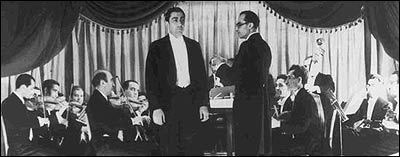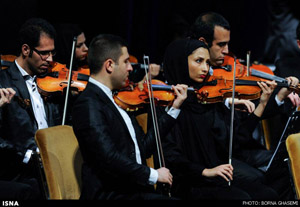

Iran's National Orchestra and its Background in IranArt of music, Monthly Magazine No. 30 Oct. 2001 By: Abbas Khosrawi Pages: Page 8 - 11 Word Count: 723 Iran's National Orchestra with its present peculiarities comprising Iranian and international musical instruments, despite being a newly-established body has its roots in a rather long background and its foundation was laid in 1901 as the Orchestra of Okhovvat (Brotherhood) Institute. Despite its being loyal to the achievements of its precedents such as Abdol-Qader Maraghei's performance of 'Morning Flower', the orchestra currently reminds one of the former Farabi Orchestra (1963) as well. Iran's National Orchestra is characterized by its present peculiarities, comprising traditional Iranian and international musical instruments, and despite appearing to be a newly-established body has not actually emerged instantaneously, but has its roots in a rather old background which should be briefly pointed out. 1. The Orchestra of Okhovvat (Brotherhood) Institute was first established by Golam-Hossein Darvish, known as Darvish Khan, who felt the spiritual need of his time for music. Making use of his inborn gift for music, he occupied himself with his fruitful innovative achievements for around eight years until his unprecedented demise. 2. The Orchestra of the Higher Musical Institute was formed in 1924 by Master Ali Naqi Vaziri and based on the scientific foundations of the peculiarities and spirit of traditional Iranian music performed for several years.  3. The Orchestra of Iran's National Institute formed by Ruhollah Khaleqi in 1944 made considerable achievements, the most significant of which was its persistence and resistance against the claims made by some people about classical music being the most impressive music worldwide and the efforts aimed at rejecting it, while another group tried to promote a type of unoriginal commercial music, which was a mixture of Indian and Arabic music. The orchestra was quite successful in achieving its objective, and its informed and efficient initiator, Ruhollah Khaleqi, later founded the National Music Institute, whose graduates gained great success in performing music in the country as well as on global level which eventually replaced the institute's orchestra. 4. Four orchestras were formed at Iran's Fine Arts Department in 1956, two of which lasted longer. Radmard Orchestra was conducted by Master Mostafa Pour-Torab for a while, and once Master Saba passed away, Saba Orchestra was conducted by Master Hossein Dehlavi under the same name until 1968, which went on to perform for three more years being renamed Rudaki Orchestra. 5. Golha Orchestra was initiated by the late Davoud Pirnia and with the cooperation of masters such as Saba, Tajvidi, Khaledi, Mahjoubi and others in 1956. However, it started to flourish since 1961 when the late Master Khaleqi and later Master Ma'roufi made many principal changes in its original foundation and left behind a worthwhile collection of musical performances in Radio Iran's archive once they rearranged and performed the musical works of the past and present music masters.  6. Farabi Orchestra, founded by the late Morteza Hannaneh in 1963, was a symphonic orchestra comprised of mainly Western musical instruments. But he rearranged and performed the musical works of Iranian composers in cooperation with other musicians, while he devised new ways of incorporating a variety of sounds into Iranian music. The orchestra lasted for six years. Meanwhile, simultaneous with Farabi Orchestra, other orchestras such as Nakisa conducted by Mostafa Kasravi, Barbod conducted by Fereidoun Nasseri and Habibollah Badi'i, and the great Radio Orchestra conducted by Iraj Golsorkhi was also formed in 1968. 7. Once Iran's Radio and Television were incorporated into a single body in 1972, the great Iranian Radio and Television Orchestra as well as all of the orchestras of Radio Iran including Golha, Nakisa, Barbod, Farabi, ... etc. fell apart and a single orchestra was formed under the conduction of Fereidoun Nasseri, which later performed under the conduction of Morteza Hannaneh for six months. It was then conducted by Farhad Fakhreddini within 1973-79, which besides recording musical pieces of Iranian musicians, performed local concerts as well. 8. Eventually in 1998 some high-ranking authorities and the officials in charge of the Music Center of the Ministry of Culture and Islamic Guidance interested in music, formed Iran's National Orchestra under the conduction of Farhad Fakhreddini which is still active and despite its background and short life seems to have achieved dazzling success.
|